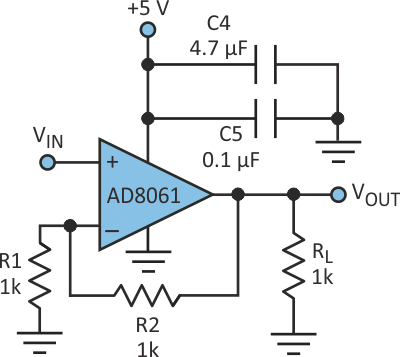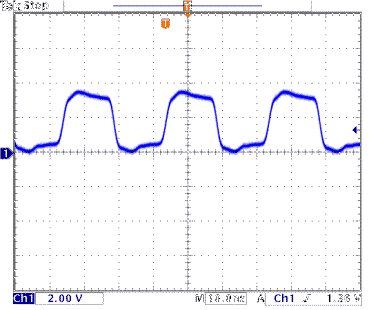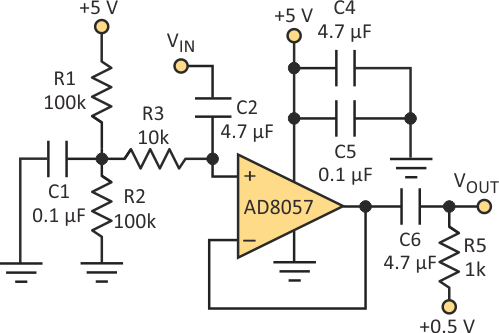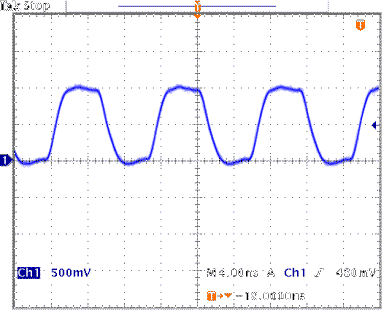In consumer electronics applications, which tend to be lower in frequency and less demanding than typical clock-buffering applications, inexpensive high-speed op amps (~100-MHz bandwidth) can offer an attractive option in place of traditional clock buffers. High-speed amplifiers can be less expensive than traditional clock buffers, yet they’re able to accommodate a wide range of design configurations.
For instance, one good alternative for low-cost clock buffers is the single-supply op amp, such as those in Analog Devices’ ADA485X family and the AD8061. These amplifiers all feature low supply voltage, low supply current, a power-down mode for power-sensitive applications, and rail-to-rail outputs, which enable wide dynamic range.
One advantage of an op amp versus a traditional clock buffer is flexibility. Op amps allow clock pulses to be buffered, amplified, offset, inverted, summed, subtracted, or filtered. They provide high input impedance, low input bias current, low supply current, independent power-down (for multiple amplifiers in a single package), low output impedance, and low propagation delay.
Designers must recognize and adhere to some operating constraints when using op amps in clock-buffer applications. For example, voltage feedback amplifiers specify a gain bandwidth product. As the closed-loop gain of the amplifier circuit increases, its bandwidth decreases. Therefore, large gains mean less bandwidth. Cascading multiple amplifiers, each with lower gain, allows the amplifier to operate at a higher bandwidth, preserving the overall gain and bandwidth of the signal path.
Single-supply operation is important for portable electronics. By definition, the input common-mode range of a single-supply op amp includes the negative rail (ground). Most can go 200 mV below ground. However, this doesn’t mean that the output can swing below ground. The output stage of a typical rail-to-rail bipolar amplifier uses a common emitter configuration. Consequently, the closest the output can come to the rail is VCE(sat), which can range from tens of millivolts to hundreds of millivolts, depending on the output load.
Fortunately, in these applications, the output doesn’t usually have to swing all the way to ground. When the input gets too close to ground (around 100 to 200 mV), though, the output stage can saturate, introducing distortion and long recovery times. In dc-coupled systems, keep the “low” of the signal above 200 mV or use a –200-mV negative supply voltage. Either method will prevent the output stage from going into saturation.
Amplifiers also specify headroom, or how close they can swing to the positive rail, so care must be taken to address the high side of the input common-mode range as well. If the input voltage gets too high, the input stage will distort and cut off.
Figure 1a depicts a single-supply non-inverting op-amp clock buffer with a gain of +2, and Figure 1b shows its transient response. As configured, the upper limit for the AD8061 is about 33 MHz. Its 2-ns propagation delay is comparable to some dedicated clock buffers.
|
||||||
| Figure 1. | Shown is a non-inverting op-amp clock buffer with a gain of +2 (a) and its transient response at 33 MHz (b). |
|||||
In some applications, ac coupling can be employed, making it possible to use higher-bandwidth amplifiers for extended frequency performance. These amplifiers will fit into single-supply applications by biasing the amplifier inputs and outputs to mid-supply.
A clock buffer implementing Analog Devices’ AD8057 highspeed amplifier was configured for unity gain (Fig. 2a). It features a 325-MHz bandwidth and 1150-V/μs slew rate. The load resistor is returned to a voltage that’s the dc average of the input signal. This ensures that the output will be referenced back to ground. The upper operating range of this configuration is approximately 100 MHz. Note that in the clock buffer’s response, good pulse fidelity is maintained at 90 MHz (Fig. 2b).
|
||||||
| Figure 2. | This ac-coupled clock buffer, which features the AD8057 high-speed amp, is configured for unity gain (a). Transient response of the ac-coupled clock buffer shows good pulse fidelity (b). |
|||||
Therefore, when a design calls for a clock buffer, a high-speed amplifier can often provide more flexibility at lower cost, enabling high-speed amplifiers to compete with traditional clock buffers in many applications. Either single-supply or dual-supply amplifiers can be employed, depending on the specific application.



